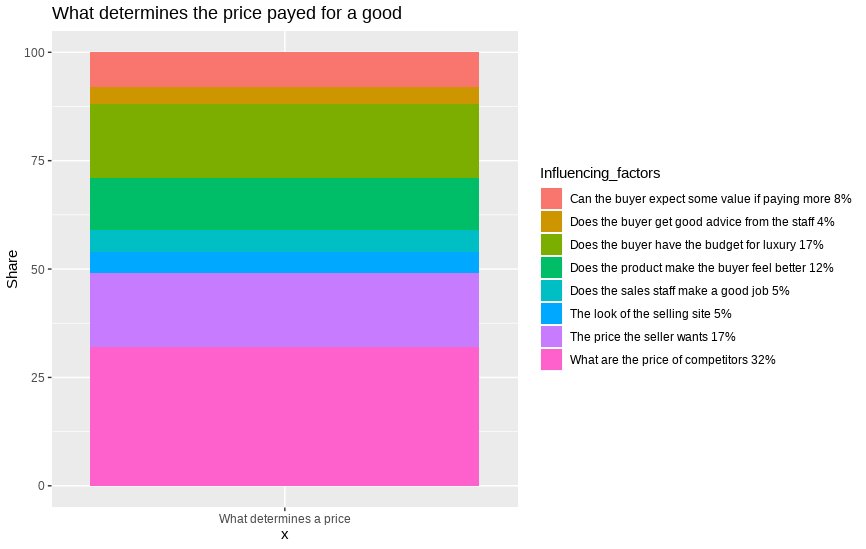Pricing affects everybody. Selling your apartment, selling used furniture, doing salary negotiations or finding prices for your products. How to find a price liked by the seller and buyer? In my seller history I found situations with low prices where the customer voluntarely added a gift, and many situations where nobody wanted to buy. The reason for this can be “no market for the product” and “price is prohibitively high”. The latter one means there is a market for the product, but not at the charged price.
The next chapters give structure to this complicated matter.
The classical theory of pricing for optimal is very simplified. It assumes a linear demand function, with only one determinant, the price: demand=f(price) . This means only demand determines the price. What happens if demand has many more determinants?
This can be:
- The look of the selling (web-)site
- Do the salesmen make a good job?
- Do I get good advice from the staff?
- Can I expect some value if I pay more?
- Does the product make me feel better?
- Do I have the budget for luxury?
- What are the prices of the competitors?
- The price the seller wants
Point 1-4 are the value to the product added by a good sales team. Example: if a retail store buys a pallet with 1000 packets pasta for 600 € and sells the package for 1,2 € the sold package is not the same product as on the pallet. The services of the retail store are added.
The following graph is an example. It may look different for a specific produkt. The graph with the numbers given there works good for used cars and expensive utilities sold on Ebay or webshops. Later in this posting I discuss the concept of a buyers persona for looking at different perceptions and factors which influence willingnes to pay.

Example: make advice a valuable good
Many brick-and-mortar retailers complain that their customers do not pay for advice. What they do not tell: how much do their prices differ from common internet sellers without any consultancy? Is there really value added in the store?
In old times, when sales was based on printed catalogs, there was the famous trade costing, with list prices, heavy rebates, and purchase prices. Most retailers ordered their stuff at wholesales, which themselves made their cuts. The result was that end user prices were about 3-10 times as high as the factory price. I understand that many want this time back. The customers had no choice, they had to buy locally. Many wishes and dreams of customers weren’t ever fulfilled for the high costs of maintaining catalogs and storage.
Now many internet retailers order directly at the manufacturers, and they have to look for competing offers worldwide.
Customer or Buyer Persona and Pricing
Customers view the product and selling environment different regarding their personal lifestyle, income and values. Depending on the product I normally look at two up to four buyers personas with different characteristics, where I draw a line between them with the help of characteristics I found with market research.
Selling Services
There are two approaches for long-term pricing: with interchangeable goods, many manufacturers, in the long run the price will be the production cost plus some earnings. The earnings are the incentive for producing. Examble: a spare part for an historic car. Production cost is 150 €, with this part added the car gains 2000 € value. If the seller knows that and wants a high price, the buyer might look for another source which produces it for 150 € and pays additional 50 € for the favor.
In Services it is a bit different. Production costs is one side. The other is: how much will the buyer profit from my service? If the seller, you, knows that 25-50% of the profit for the seller, the trainer or consultant, are normal.
Is there a formula for prices?
In economic theory the price is equal to marginal use. That means the price equals the benefit the buyer thinks he has from the last unit he or she buys.
If we can measure the benefit in money and realtime, we have the formula.
The benefits are listed at the beginning of the article. The problem is that the customer does so many estimations, that change over time. Also new competitors with low price entrance strategy might show up.
When selling over a website it is quite easy. Look at the ones who buy related to the ones who look at the article. If there are many who look and do not buy then lower the price, if most of the visitors buy then raise. This needs a lot of finetuning. Sometimes visitors look a few times at the articles until they finally buy. When they see that the prices go down, they might wait even longer. So you might want to include the total number of visitors.
How to calculate?
There is a mathematical formula and there are ways to survey it.
We measure the first eight determinants, with due consideration of costs:
| determinant | how to find and count |
| The look of the sales (website) position. | Survey of visitors |
| Are the salespeople doing a good job? | not available everywhere, get feedback |
| Do I get good advice from the staff? | Get feedback |
| Can I expect value if I pay more? | Tests and surveys on buying motivation, own samples |
| Do I feel better because of the product? | Tests and surveys on buying motivation |
| Do I have the budget for luxury? | Experiments, interviews |
| What are the prices of the competitors? | Research |
| The price the seller wants | Look deep inside you |
Market research helps with the first six points. Usually it is necessary to repeat the market research every 3-6 months with the well-known market research problem: the target person doesn’t like to answer. They are bored and do not know whatfor they took their time to answer the questions. We must therefore look for other methods. An easy-to-install method is to encourage visitors to comment. You may get 1-5% comments from the customers. This responses add up to valuable data source. It is also possible to conduct studies with paid testers. There are some problems with representation of the correct user group there, additional research helps to circumvent this.
Photo du titre by Egor Myznik on Unsplash

